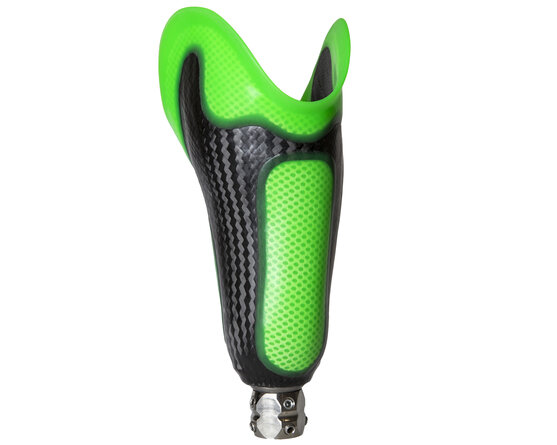
Lower leg prostheses consist of a shaft and a foot part.
We train you in the daily use of your lower leg prosthesis.
Make an appointment over the phone or send us a message!

Selecting the right shaft system
Various prosthesis designs are used in lower leg prosthetics. They differ primarily in the type of body connection, i.e. in the shaft system.
A detailed consultation first provides important information on the selection of the appropriate shaft technology. It is important that both your private and professional needs are included in the planning.
The selection of the right shaft system is significantly influenced by the following factors:
- your individual wishes and needs
- care history,
- clinical conditions
Interim prosthesis for lower limb amputees
Frequently asked questions
An interim prosthesis is a temporary prosthesis. In the first few months after a leg amputation, the conditions of the residual limb can still change considerably. The interim prosthesis, also called provisional prosthesis, is used to bridge this phase.
The socket of the interim prosthesis (i.e. the connecting piece between the person and the technology) is not initially made of carbon so that it can be easily adapted to the ever-changing shape of the leg stump during the "trial period". In the case of freshly amputated patients, the circumference of the leg stump is reduced during the first few months. This is due to the healing process of the wound and the reduction of the swelling. In addition, the user can test different fitting parts (e.g. knee joints or different foot parts) during the 6-month interim phase, which are then installed in the final prosthesis. The fit of the prosthesis socket is repeatedly improved by our orthopedic technicians during the interim phase so that as few fitting problems as possible occur with the definitive prosthesis with carbon socket.
How quickly you learn to walk with a prosthesis depends on many different factors. These include, for example
- the wound healing on the residual limb,
- the accuracy of fit of the prosthesis,
- one's own resilience,
- the rehabilitation,
- the muscle building
- etc.
Some users can walk from A to B relatively safely within a few days of receiving their interim prosthesis, while for others this process takes several weeks.
Policeman Alex shows what is possible with a lower leg prosthesis.
Overview
The shaft systems
The various shaft systems are differentiated according to their adhesive and functional principles.
The following systems are currently in use:
- Condyle bedding systems (e.g. KBM shafts)
- Liner systems with distal locking
- Vacuum systems:
- Liner systems with knee cap
- Liner systems with sealing lip
Clear assignment of the shaft systems is not always easy, as the different modes of action of the individual adhesion and functional principles are often combined.


With condyles we are talking about bony parts of the knee joint at the lower end of the thigh bone, which are responsible for a combined rolling and sliding movement on the articular surface of the head of the tibia. KBM (Kondyl Bettung Münster / condyle bedding Münster) is a shaft embedding method that encloses the condyles. In Kondyl Bettung Munster systems, the inner and outer shafts are locked by an enclosure over the condyle.
To put on the lower leg prosthesis, the stump is first wrapped with a skin protection stocking and slightly pre-compressed. The soft tissues are thus fixed and prepared for the prosthesis. Through a slot at the end of the soft-wall inner socket, the stump is pulled into the inner socket with the aid of a Perlon tube.
Subsequent adjustments following shape changes can be made quickly with these systems. This means that any volume fluctuations can be easily adjusted with compensation socks. The soft-wall inner socket can be narrowed in the same way.
In particular, condylar bedding systems show their strengths in initial treatments and in atrophic stump conditions. The loads on the end of the stump are minimized.

Silicone is a very popular liner material. It is available in different versions and shore hardnesses. The silicone liner ensures that the prosthesis remains firmly attached to the lower leg. It also holds the stump evenly and has skin-care and protective properties.
In liner systems with distal locking, the silicone liner is pushed onto the stump like a second skin. For a secure hold, it is then secured inside the prosthesis shaft with a lock. This lock is called a retainer. The retainer pin attached to the liner snaps into the counterpart fastened in the shaft. This creates a firm connection between the amputation stump and the prosthesis. A major advantage of distal retainers is the ease of use of the system.

Vacuum systems create a vacuum between the liner and the shaft. From a biomechanical point of view, vacuum systems offer decisive advantages in terms of the fixation of the prosthesis shaft to the stump. The adhesive principle of negative pressure is distributed over the entire surface, which is sealed airtight, instead of being selectively distributed over a small area on the stump. This means that the weight forces of the prosthesis are transferred to the stump much more efficiently.
Furthermore, negative pressure can be built up passively or actively. In the active variant, the air is transported out of the shaft by technical aids. Many users report better feedback from the prosthesis in the event of uneven floors, for example. Studies have shown that an active vacuum system has a positive effect on dull blood flow and volume fluctuations.
We use two different types of vacuum systems:
- Liner systems with knee caps
- Liner systems with sealing lip

Liner systems with knee caps:
The knee cap is applied over the shaft up to the thigh. It is necessary to build up and seal off the vacuum. The vacuum created between the knee cap and the end of the liner acts over the entire surface of the stump. Consequently, the core also absorbs the weight force of the prosthesis over the entire area, which in turn reduces the local load.
The liners are offered as bedding liners in all different materials such as silicone, TPE and PUR. Here too, special situations can be addressed with individual or pre-assembled compensation.
Liner systems with sealing lips:
In recent years, silicone liners with sealing lip systems in different designs have established themselves. These systems also take advantage of vacuum. However, the technique for putting on this type of liner is difficult. As a rule, users are dependent on an alcohol-based aid for putting on the orthosis. It ensures that the adhesion force is kept low when pushing onto the stump and when sliding into the shaft.
Liner systems with sealing lips offer a maximum build-up height for long stump treatments in order to be able to mount active or high-build-up fitting parts under the shaft. The wearing comfort is generally very high, as there is no need for additional materials above the knee joint.
Patient story
Dimitri's new start with a prosthesis
He actually just wanted to spend a nice evening with friends - but then everything changes: novice driver Dimitri gets into a car accident. After several months in a coma, he thinks he has overcome the worst. But Dimitri's left leg just won't heal...


Let yourself be inspired! We follow many interesting patients during their Pohlig appointment and give you personal insights.

For those who want to delve even deeper into the subject, we have a suitable video for almost every area of treatment!

Take a look behind the scenes at Pohlig and learn about different health conditions and our innovative assistive technology solutions!

Sometimes funny, sometimes explanatory, sometimes emotional - but above all always entertaining: our videos on TikTok!


